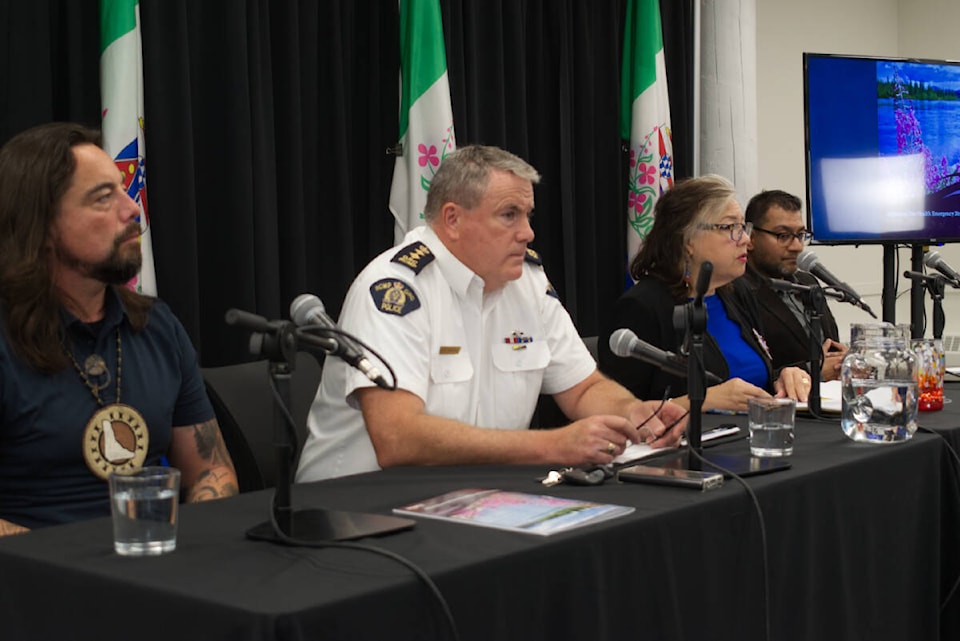Nineteen months after declaring a territory-wide substance use health emergency, the Yukon government has released its substance use health emergency strategy without timelines, implementation plans or cost for the 43 recommended actions.
The proposed actions unveiled Aug. 23 range from upping support for attention deficit hyperactivity disorder diagnosis and treatment to implementing a managed alcohol program, extending the hours of Whitehorse’s supervised consumption site and opening a sobering centre and a sober shelter.
“Addressing the substance use health emergency is our government’s highest priority,” Tracy-Anne McPhee, the minister of Justice as well as Health and Social Services, said during a press conference scheduled around the release of the strategy.
McPhee described the strategy as a “living, adaptable roadmap that will guide our ongoing response to the many substance use issues in the territory including those related to alcohol.”
“The launch of the substance use health emergency strategy marks a significant step, but it is only the beginning,” she said.
“Our work continues as we develop responses to save lives and build healthier communities. To achieve our goals, we will need to maintain our focus, invest our resources wisely and continue to enhance our partnerships across the Yukon.”
READ MORE: Yukon declares substance use emergency
The strategy represents an “urgent call to action,” according to Cameron Grandy, director of substance use services in the Health and Social Services department, who spoke during a technical briefing held prior to the press conference.
Grandy said the document was informed by the Council of Yukon First Nations, Blood Ties Four Directions, Connective, RCMP, Yukon hospitals, all First Nations and First Nations health departments, many different government agencies and people who have lived experience.
Grandy noted a few factors behind the delay of the strategy, which the minister previously said could be out in May, such as the number of approaches that had to be considered and voices that had to be heard.
“Sometimes, it’s hard to see with the health emergency,” he said, noting there’s not a set amount of work to hold the fire back or sandbags to keep the water out like in other emergencies.
Chief medical officer of health Dr. Sudit Ranade presented data to the press conference.
In 2022, the age-adjusted rate of opioid toxicity deaths in the Yukon was twice that of the nationwide average.
“When you look over at alcohol use, the age-adjusted rate of alcohol-related hospitalizations in 2020 in the Yukon was almost seven times the rate of Canada,” he said.
“That is a pattern that has stayed consistent for many, many years.”
Ranade said the burden in the Yukon is heavier than the rest of the country, and the roots of substance use run deep.
“We can’t just intervene on one level or in one space,” he said.
Per the document, the desired outcomes of the strategy are delaying the age of starting substance use, minimizing substance use across the lifespan, keeping people safe when using substances, reducing the harms of substance use and improving the health, safety and wellbeing of Yukoners.
READ MORE: Coroner confirms 8 substance-use related deaths over span of less than 3 weeks
At the press conference, Yukon RCMP Chief Superintendent Scott Sheppard said the police remain focused on targeting the source of illicit drugs and those who traffic them. Measurable costs of substance use include deaths due to overdose, the physical and mental impacts on individuals and families, the deterioration or decay of neighborhoods and communities and the impact on businesses and public spaces, he said.
Sheppard considers the document a roadmap “with some major thoroughfares and arteries marked on it, but some of the smaller roads and pathways, we still need to figure those out.”
“I know that we may hit the occasional roadblock or a speed bump along the way, but that doesn’t mean we stop trying. It means we regroup; we rethink the strategy.”
The strategy indicates that some of the recommended actions are already happening, while others will span across multiple years and require more research, analysis and teaming up with partners to be fully carried out.
Grand Chief Peter Johnston of the Council of Yukon First Nations noted the complexity behind substance use tied to the consequences of losing culture, language, family dynamics and pride.
“We’re starting to see the detrimental effects of policy […] however, we can only blame government for so long,” he said.
“In the ’70s, and ’80s, we knew who the leaders were in the community, they weren’t elected, they were the ones that would not tolerate, you know, the situations that we deal with today and affect all of us.”
Johnston said Yukon First Nations need to “find our way back on our path” and “take our rightful place.”
But he doesn’t want to see a political campaign. He wants to see leaders step up.
“We need to take action today,” he said.
“There’s a lot of people sitting on their hands within the government [..] let’s call a spade a spade, you know, the bureaucracy in some cases becomes too big.”
Johnston suggested the Yukon government could divest from mining, for example, to put more money into supporting the strategy.
“We’re hanging by a thread, you know. Where’s the investment back into the medical field in order to support this?” he said.
Johnston tried to be optimistic.
“We can’t give up, and that’s the bottom line,” he said.
“I’m going to push government as hard as I can.”
The Yukon’s access-to-information registry indicates a copy of the draft strategy submitted to First Nation governments for review was requested of the health department in May. That request was withheld in full, citing cabinet records.
The strategy indicates that the Yukon government will report each year on the status of the recommendations.
Contact Dana Hatherly at dana.hatherly@yukon-news.com
